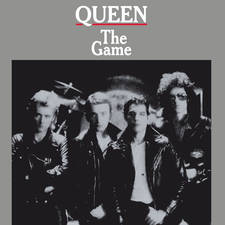Bing Crosby facts: Songs, films, real name, life and death of the 'White Christmas' icon
12 December 2023, 11:51 | Updated: 16 January 2024, 12:29

Mary Crosby interview: Bing Crosby's daughter looks back at White Christmas
Bing Crosby was not just a music and movie superstar, but also a pioneer of the recording age.
Listen to this article
If Bing Crosby had only ever recorded 'White Christmas', his place in the culture and record books would be assured.
With an estimated 50 million sales, it's the biggest selling single of ALL TIME, and as we go into the streaming era that number is only going to get higher.
- Bing Crosby’s daughter Mary reveals it was bittersweet hearing ‘White Christmas’ after star’s death
- 'Peace on Earth/Little Drummer Boy' by David Bowie and Bing Crosby: The making of the classic duet
- Listen to the Gold Christmas Live Playlist on Global Player. the home of Gold
But Bing was so, so much more than 'White Christmas'. He recorded over 1,600 songs and released more than 400 singles and 70 albums.
He was also an Oscar-winning actor who starred in over 70 feature films, and was an ever-present on radio for three decades.
Bing also was a leader in the latest (for the time) recording techniques, which made him a true musical pioneer who paved the way for the pop era. Here's his story.
When and where was Bing Crosby born and what was his real name?

Bing was born Harry Lillis Crosby Jr. on May 3, 1903 in Tacoma, Washington as the fourth of seven children of bookkeeper Harry Lowe Crosby and Catherine 'Kate' Helen Rose.
He attended Gonzaga High School and later went to the private Jesuit Gonzaga University in Spokane, Washington for three years, but he didn't actually earn a degree, though they did later bung him an honorary doctorate in 1937.
As to how he got his nickname, he explained in 1937: "Back in the knee-britches day, when I was a wee little tyke, a mere broth of a lad, as we say in Spokane, I used to totter around the streets, with a gun on each hip, my favorite after school pastime was a game known as 'Cops and Robbers'.

Bing Crosby - Ol' Man River (Live From "The Bing Crosby Special" / 1959)
"I didn't care which side I was on, when a cop or robber came into view, I would haul out my trusty six-shooters, made of wood, and loudly exclaim bing! bing!
"As my luckless victim fell clutching his side, I would shout bing! bing! and I would let him have it again and then as his friends came to his rescue, shooting as they came, I would shout bing! bing! bing! bing! bing! bing! bing! bing!"
But it turns out he was just spinning a yarn, as five years earlier it was reported that his neighbour Valentine Hobart who had nicknamed him "Bingo from Bingville" when he was seven years old.
The name came from a comic character in the local The Bingville Bugle, with it later getting shortened to plain old Bing.
How did Bing Crosby get into music?
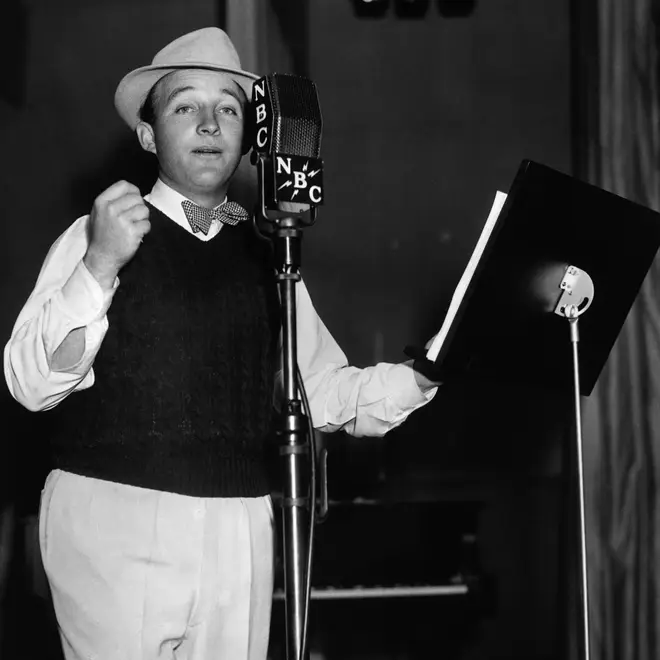
When Bing Crosby was just 14, he got a job as a property boy at Spokane's Auditorium, where he got the chance to see acts including Al Jolson, who was a massive inspiration to the young Bing.
At the age of 20, he was asked to drum with with some younger lads and lasses – Al and Miles Rinker, James Heaton, Claire and Robert Pritchard – as the Musicaladers, performing at clubs and high school dances for a couple of years
He also was part of various groups including The Three Harmony Aces, The Clemmer Trio and The Clemmer Entertainers, who played between movies at the Clemmer Theater.

I've Got The Girl!
Looking to spread their wings, Bing and Al Rinker travelled to LA In 1925 and joined The Syncopation Idea at the Boulevard Theater, and then the Morrissey Music Hall Revue, before moving to the Tivoli Theatre in Chicago.
Bing's first record, recorded with Rinker and Don Clark's Orchestra, was released in 1926. Unfortunately 'I've Got The Girl' was recorded at the wrong speed, shifting up the singers' pitch during playback.
They then joined forces with talented songwriter Harry Barris and Paul Whiteman as The Rhythm Boys, with Crosby emerging as the star, with his version of 'Ol' Man River' he scored his first number one in 1928.
Bing Crosby had arrived.
What were Bing Crosby's biggest songs, and did he write any of them himself?

White Christmas (Official Video)
As we've said, Bing recorded over 1,600 songs during his career, including a string of classics.
He wasn't a prolific songwriter, but did write or co-write the lyrics to just over 20 tracks, including some mahor hits
It's impossible to really hack down a list of Bing songs to anything even slightly manageable, but of his very biggest and best songs include versions of:
- Ol' Man River
- Mississippi Mud
- Makin' Whoopee
- Louise
- I'm A Dreamer, Aren't We All?
- Three Little Words
- Just a Gigolo
- Out of Nowhere
- Wrap Your Troubles in Dreams
- At Your Command
- Stardust
- Dancing in the Dark
- I Apologize
- Sweet and Lovely
- Goodnight, Sweetheart
- Dinah
- Sweet Georgia Brown
- Waltzing in a Dream
- Brother, Can You Spare a Dime?
- I Don't Stand a Ghost of a Chance with You
- Temptation
- Love in Bloom
- June in January
- Soon
- It's Easy to Remember
- Red Sails in the Sunset
- Pennies from Heaven
- Sweet Leilani
- Too Marvelous for Words
- Alexander's Ragtime Band
- You Must Have Been a Beautiful Baby
- God Bless America
- Only Forever
- White Christmas
- Sunday, Monday, or Always
- Pistol Packin' Mama
- Jingle Bells
- I Love You
- I’ll Be Seeing You
- Swinging on a Star
- Don't Fence Me In
- Now Is the Hour
- Some Enchanted Evening
- True Love
- Peace on Earth/Little Drummer Boy
How did Bing Crosby revolutionise music with his recorded work?
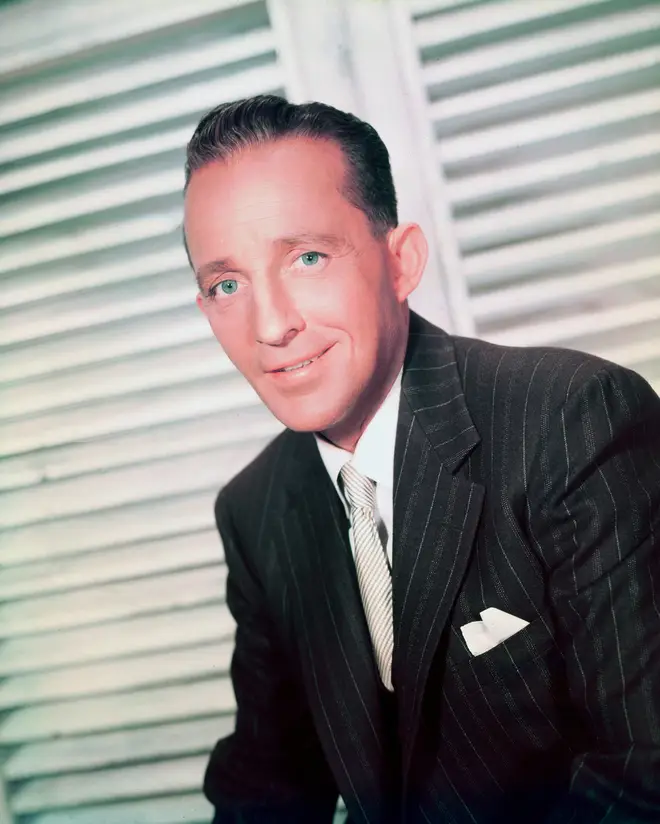
Beyond being the frontman (and sometimes songwriter) of some major hits at the dawn of the pop age, Bing Crosby was also a recording music pioneer.
While his major predecessors had done what they could to translate their on-stage vocals to plastic, Bing was among the first to really make use of the technological capabilities of both microphones and tape recording.
Not having to belt out your vocals to reach the cheap seats meant that Bing could really focus on phrasing in a way few had done before, helping to create the crooning style that would dominate the pop scene in the pre-rock 'n' roll years.
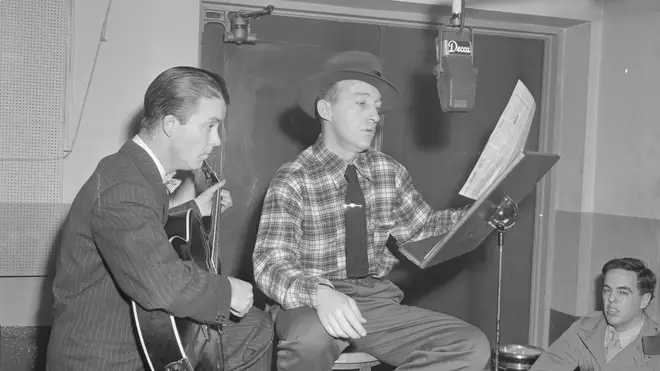
After WWII, Bing invested a then-massive $50,000 in California electronics company Ampex to make copies of a German reel-to-reel tape recorder that offered broadcast quality.
He strong-armed ABC into letting him pre-record his radio shows rather than broadcast them live,
Bing also used the burgeoning technology to master his music onto magnetic tape, making use of tools like editing, retakes and time-shifting to make recording a song much more like making a movie than the "press record and hope" approach that came before.
What films did Bing Crosby star in?

Going My Way (1944) - Official Trailer
It's important to remember that during Bing's heyday, it wasn't a case that musicians were trying their hand at movies, or actors were giving it a go in the studio.
The worlds of music and the movies (and to an extent radio and theatre), were very much intertwined. Many of Crosby's biggest hits were introduced by Bing himself in films in which he starred.
Bing's first role was as one of The Rhythm Boys in 1930's King of Jazz, and he continued to appear on the silver screen all the way up to the mid 1970s.

The Country Girl - Trailer
We won't list every single one of Bing's film roles, of course, but we'll make special mention of 1944's Going My Way, for which he won the Academy Award for Best Actor.
He also picked up a nod for the following year's sequel The Bells of St Mary's, and a third for 1954's The Country Girl. We can't not mention 1942's Holiday Inn, which debuted 'White Christmas', later reprised in 1954's White Christmas as the title song.
Bing Crosby's key movie roles included:
- King of Jazz
- The Big Broadcast
- College Humor
- Anything Goes
- Pennies from Heaven
- Holiday Inn
- Dixie
- Going My Way
- The Bells of St. Mary's
- Blue Skies
- Here Comes the Groom
- White Christmas
- The Country Girl
- Anything Goes
- High Society
- Man On Fire
- High Time
- Robin and the 7 Hoods
- Stagecoach
What were Bing Crosby's major radio and TV shows?

Bing Crosby, David Bowie - Peace On Earth / Little Drummer Boy
Bing's stardom crossed from the studio, cinema and stage into the small screen and radio too.
He dominated radio for 30 years, from the six-times-a-night 15 Minutes with Bing Crosby in 1931 and The Bing Crosby Show to The Bing Crosby – Rosemary Clooney Show, which ended in 1962.
We also have to mention Bing Crosby on Armed Forces Radio in World War II, which ran from 1941–1945.
He was a bit more wary of telly, making his nod as late as 1954 with The Bing Crosby Show, which continued in various forms for a decade or so.
Bing popped up on other's people shows – Ed Sullivan, Bob Hope, Dinah Shore, Dean Martin, Joey Bishop etc. etc. – over the years.
One show that has to be mentioned is Bing's final TV appearance fronting Bing Crosby's Merrie Olde Christmas, which was filmed in September 1977 and aired on November 30, 1977, weeks after Crosby had died.
How many times was Bing Crosby married and did he have any children?
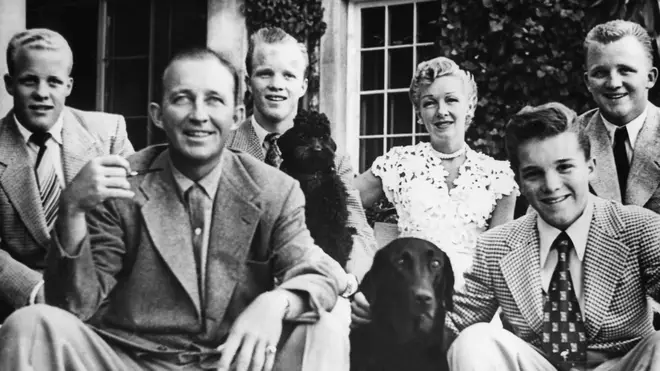
Bing Crosby was married twice, wedding actress and nightclub singer Dixie Lee in 1930 and remaining married – despite issues around her alcoholism – until she died from ovarian cancer in 1952.
They had four sons together: Gary, twins Dennis and Phillip, and Lindsay. Bing was reported to have an affair with Joan Caulfield in the 1940s, but eventually broke it off and reconciled with Dixie before her eventual passing.
Bing then married Kathryn Grant in 1957, and they had three children: Harry Lillis III, Mary Frances and Nathaniel.
Between his two marriages, Crosby had relationships with model Pat Sheehan and actresses Inger Stevens and Grace Kelly.
When did Bing Crosby die and how old was he?

Bing Crosby - White Christmas (From "Bing Crosby's Merrie Olde Christmas")
Into the 1970s, Bing struggled with ill health, having suffered a life-threatening fungal infection in his right lung in January 1974.
Despite these issues, he went out of semi-retirement to record new albums and play live. He suffered a serious fall into an orchestra pit after taping the Bing – 50th Anniversary Gala performance at the Ambassador Auditorium on March 20, 1977 and had to spend a month in hospital with a ruptured disc.
Nevertheless he continued working. He was in the UK that autumn on tour with Rosemary Clooney, and it was on these shores where he recorded his final TV Christmas special, which featured the 'Little Drummer Boy/Peace On Earth' duet with David Bowie on September 11.
His last show took place on October 10 at the Brighton Centre, and the following day he recorded an eight-song set at Maida Vale Studios, closing with 'Once in a While'.

Once In A While
He flew to Spain to play golf with some pals, and on October 14 was in good enough spirits to serenade some construction workers with 'Strangers in the Night' when they asked for a tune
On his way back to the clubhouse, Bing said his final words: "That was a great game of golf, fellas. Let's go have a Coca-Cola."
He sadly collapsed and died of a massive heart attack, with club physician unable to revive him. He was prounounced dead at the Reina Victoria Hospital. He was 74.
A private funeral was held at Mass at St. Paul's Catholic Church in Westwood and Crosby was buried at Holy Cross Cemetery in Culver City, California.
